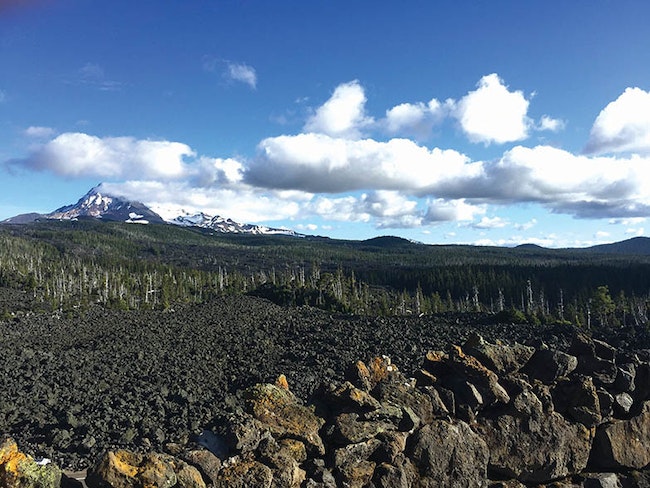 LINDA SEXTON/PHOTO
LINDA SEXTON/PHOTO
Please join us on a worthy trip with three destinations, the Lavender Gardens, Belknap Hot Springs, and the Dee Wright Observatory.
We enjoyed The Chronicle pictorial July 16 covering the Lavender Gardens.
As Linda and I travel the McKenzie Highway, the Lavender Gardens are located five miles from the center of Walterville, across from the Walterville School. Their brochure says “come explore bloom on the farm, mid June through late July, 541-736-8575.” Due to the virus, it was very modified this year, and it was a worthwhile event, waking through the lavender beds, and watching boaters float by on the McKenzie. There is a $10 charge per ticket. A few venders had lavender soap and other items for sale. With the admission fee, you got a beautiful bouquet of lavender.
Then we continued up Highway 126 to Hot Springs. It is a beautiful resort campground/gardens on the McKenzie River. As you pull into the parking lot next to the lodge, you hear the distinctive and wonderful sound of the McKenzie as it rushes over a rocky river bottom.
When we came back to the car, there was a family floating the river. The river is very visible from the indoor pool and the large patio adjacent to the indoor pool. They offer two hot mineral pools. Bathing suits are required. The lodge offers 18 spacious lodge rooms, 8 cabins, and 12 tent sites, and 47 RV sites. It is a pet friendly location, and they must be on leash. There are laundry and shower facilities on site. There are many trails for the hikers. Rafting, hiking, golfing, boating, in the summer, and winter sports come winter.
While Linda and I were on site, the restaurant was not open, probably due to the virus. There were many people throughout the area who had picnic baskets.
The next destination was the Dee Wright Observatory at the summit of the Old McKenzie Pass. Just a short distance from the Springs is a junction in the road where Highway 242 takes off from 126 over the Old McKenzie Pass. The pass was originally discovered by John Latta, and developed into a wagon road between 1866 and 1870.
Latta worked with a man named Craig to create the wagon road into the automobile road, from 1919-25. An alternate bypass highway over the McKenzie at a lower elevation, and far less curves, was completed in 1964. The Old McKenzie is very difficult to keep open in heavy snow, making it necessary for the route into Springfield The Old highway elevation is 5,187 feet.
Several miles both sides of the summit, the road is cut through lava fields that extend miles each side of the road and measure 65 square miles.
On the west side, going up, you view old growth Douglas fir, vine maple, Western red cedar, red alter, and Oregon ash. There are a few large blue spruce on private lands. The west side is a beautiful drive. As you climb to the top, you see old growth Douglas Fir, and the underbrush is minimal at this point.
At the summit is the Dee Wright observatory. From this observatory, built in 1935 from lava rock by the CCC, you can view 17 different mountain peaks and two craters. The observatory is built with small windows. As you look out through a window, you are looking at a certain mountain – Mt. Jefferson, Mt. Washington, North and Middle Sister, and two major craters, which the lava flows came from.
On a clear day, you can see Mt. Hood. There is a 0.8-mile trail that forms a circle. The lava fields are very difficult to walk on – very sharp and uneven. The lava fields extend for miles on both sides of the summit. The depth of lava ranges from five feet to over 75 feet in places. There are many snags that found life for a short time in the pockets of moisture and sand in the lava. They stand as sentinels . For the nature lover and geologist, and for those of us who enjoy the adventure of seeing your home state, a few-hour trip on highway 242 and the observatory is highly recommended. The McKenzie Pass is also used by many bicyclists.
You will be greeted at this point where three counties come together: Linn, Lane, and Deschutes meet at the summit.
Also, the north crest trail is in this immediate vicinity.
Linda and I made the complete circle, as we went down the east side of the Old McKenzie to Sisters, and then back through Black Butte and into Springfield, and home.
As you leave the summit, you come into old growth lodgepole pine – grasslands under the trees, and great habitat for cattle and deer. The one distraction on the trip down the east side of the McKenzie is miles of burnt poles that were once lodgepole pine – forest fires and bug kill.
Beautiful forest with very little undergrowth.








